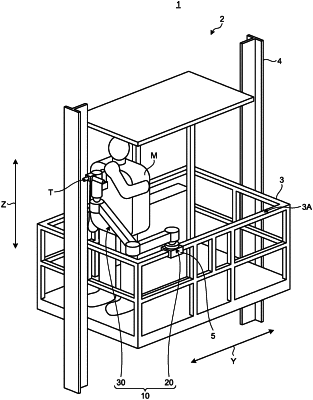| CPC B25J 9/1651 (2013.01) [B25J 9/04 (2013.01); B25J 9/1674 (2013.01); B25J 9/1694 (2013.01); B25J 13/085 (2013.01); B25J 13/088 (2013.01); B25J 17/02 (2013.01); B25J 19/0004 (2013.01)] | 14 Claims |

|
1. A work support device comprising:
an arm including a grasping part that grasps an object, a plurality of joint parts, and a plurality of link parts actuatably coupled through each joint part;
a brake provided to at least one of the joint parts that restricts actuation of the arm;
a linear movement slider that is provided to a scaffold capable of accommodating a worker and that supports the arm;
a processor; and
a memory storing instructions that, when executed by the processor, cause the processor to:
determine a state of the arm; and
control the brake to restrict the actuation of the arm in accordance with the state of the arm,
wherein
the grasping part and one of the link parts are coupled with each other through one of the joint parts, and the link parts are coupled with each other through one of the joint parts,
the brake restricts actuation of the arm by restricting actuation of the at least one of the joint parts, and
the memory further stores instructions that, when executed by the processor, cause the processor to:
derive a target angle that is a joint angle of each joint part when the grasping part is positioned at a target position,
determine, as the state, whether at least one of the joint parts has reached the target angle, and
control the brake to restrict the actuation of the arm by restricting the actuation of the joint part determined to have reached the target angle.
|